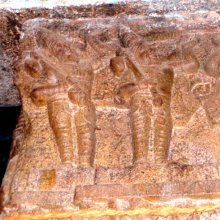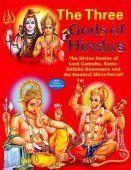Rishi, Ṛṣi, Rsi, Riṣi, Ṛṣī: 34 definitions
Introduction:
Rishi means something in Buddhism, Pali, Hinduism, Sanskrit, Jainism, Prakrit, the history of ancient India, Marathi, Hindi, Tamil. If you want to know the exact meaning, history, etymology or English translation of this term then check out the descriptions on this page. Add your comment or reference to a book if you want to contribute to this summary article.
The Sanskrit terms Ṛṣi and Riṣi and Ṛṣī can be transliterated into English as Rsi or Rishi or Risi, using the IAST transliteration scheme (?).
Images (photo gallery)
(+21 more images available)
In Hinduism
Purana and Itihasa (epic history)
Source: archive.org: Puranic EncyclopediaṚṣi (ऋषि).—Agni Purāṇa, Chapter 348 states that the letter "Ṛ" means "sound". The word "Ṛṣi" is derived from this root. During the period when the art of writing was not known, Vedas, Śāstras and other sacred lore were communicated through the mouth of the Ṛṣis. The voice of Āṛṣa Bhārata itself is the voice of the Ṛṣis. Hindus believe that the Vedas are the outcome of the inspiration, introspection and spiritual vision of the Ṛṣis. There is a Saṃskṛta stanza defining a Ṛṣi, which is given below:
"ūrdhvaretāstapasyāgaḥ niyatāśī ca saṃyamī / śāpānugrahayoḥ śaktaḥ satyasandho bhavedṛṣiḥ //"
India has given birth to numerous Ṛṣis. The word "Ṛṣi" may be found throughout the Vedas. Ṛṣis born in all classes of people had lived in India. The general belief is that the number of Ṛṣis may come to about 48,000. It is not possible to know the names of all of them. In the Rāmāyaṇa we find that when Śrī Rāma returned to Ayodhyā after his life in the forest and took up the reign, many Ṛṣis came to Ayodhyā from all parts of the country. Among them, Viśvāmitra, Yavakrīta, Raibhya, Kaṇva and Garga came with their party of disciples from the east; Dattātreya, Namuci, Pramuci, Vālmīki, Soma, Kuṇḍu and Agastya came with their disciples from the south; Vṛṣaṅgu, Kaviṣa, Kaumya, Raudreya, Nārada, Vāmadeva, Saubhari, Aṣṭāvakra, Śuka, Bhṛgu, Lomaśa, Maudgalya and others with their disciples came from the west and Kaśyapa, Vasiṣṭha, Atri, Gautama, Jamadagni, Bharadvāja, Sanaka and party, Śarabhaṅga, Durvāsas, Mātaṅga, Vibhāṇḍaka, Tumburu, the Saptarṣis and others with their party of disciples arrived from the north, according to Uttara Rāmāyaṇa. There are three classes of Ṛṣis—Brahmarṣi, Rājarṣi and Devarṣi. Vasiṣṭha was a Brahmarṣi, Visvāmitra, a Rajarṣi and Kaśyapa, a Devarṣi.
Source: Cologne Digital Sanskrit Dictionaries: The Purana Index1a) Ṛṣi (ऋषि).—(ety.)—got the mantras by the pupil of the eye, by observation, by accident and by past and future events. Five groups are distinguished: avyaktātmā, mahānātmā, (also mahātmā), ahaṅkārātmā, bhūtātmā and indriyātmā; also brahmaṛṣis, devaṛṣis, rājaṛṣis, mahaṛṣis, saptaṛṣis, ṛṣika—all mantravits.1 Milked the cow Earth when Soma acted as calf; Bṛhaspati was the milkman, the vessel being the Vedas and the essence tapas;2 cursed by Mahādeva in the Svāyambhuva epoch and freed from it in the Vaivasvata.3 agnihotra—Ṛsis procreate for the world and establish dharma in it; live in the pitṛyāna. gṛhamedhi rṣis; 88,000; live in the southern path of the sun till the end of the world;4 quality of immanence in them; kinds of;5 place of 8000 sages.6
- 1) Brahmāṇḍa-purāṇa II. 32. 70-95; 33. 32, 34; 35. 89 & 95; Matsya-purāṇa 123. 29; 145. 81-89. Vāyu-purāṇa 59-87.
- 2) Matsya-purāṇa 10. 16-7.
- 3) Matsya-purāṇa 195. 3.
- 4) Matsya-purāṇa 124. 98-100, 102-4.
- 5) Vāyu-purāṇa 5. 35; 49. 126; 59. 63.
- 6) Brahmāṇḍa-purāṇa II. 7. 180.
1b) (Paramaṛṣi, Ṛṣitā, Mahaṛṣis, Ṛṣikas, Ṛṣiputrakas, Śrutaṛṣis) and ṛṣijāti, ety. of.*
- * Vāyu-purāṇa 59. 79-87.
1c) Blessed Pṛthu.1 Divine ascetics.2 Went to Dvārakā to see Kṛṣṇa.3 Sing in praise of the sun.4 Born in the form of cows when Hari manifested himself as Kṛṣṇa.5 (See ṛṣi). The seven of the Vaivasvata epoch were Viśvāmitra, Jamadagni, Bharadvāja, Śaradvān, Atri, Vasumān, VatsāraKaśyapa.6 Relations of, with gods and Pitṛs.7
- 1) Bhāgavata-purāṇa IV. 15. 19; 19. 18.
- 2) Ib. III. 20. 52-3; VII. 8. 37 and 43; VIII. 5. 39; 14. 8; X. 72. 8; 74. 37.
- 3) Ib. XI. 6. 3.
- 4) Ib. XII. 11. 47.
- 5) Ib. X. 1. 23 [1].
- 6) Vāyu-purāṇa 64. 24-28.
- 7) Ib. 62. 21.

The Purana (पुराण, purāṇas) refers to Sanskrit literature preserving ancient India’s vast cultural history, including historical legends, religious ceremonies, various arts and sciences. The eighteen mahapuranas total over 400,000 shlokas (metrical couplets) and date to at least several centuries BCE.
Natyashastra (theatrics and dramaturgy)
Source: Wisdom Library: Nāṭya-śāstraṚṣi (ऋषि) refers to “vedic seers”, whose beard (śmaśru) should be represented as bushy (romaśa), according to Nāṭyaśāstra chapter 23. Providing the beard is a component of nepathya (costumes and make-up) and is to be done in accordance with the science of āhāryābhinaya (extraneous representation).

Natyashastra (नाट्यशास्त्र, nāṭyaśāstra) refers to both the ancient Indian tradition (shastra) of performing arts, (natya—theatrics, drama, dance, music), as well as the name of a Sanskrit work dealing with these subjects. It also teaches the rules for composing Dramatic plays (nataka), construction and performance of Theater, and Poetic works (kavya).
Vaishnavism (Vaishava dharma)
Source: Pure Bhakti: Bhajana-rahasya - 2nd EditionṚṣi (ऋषि) refers to:—A sage learned in the Vedas. (cf. Glossary page from Bhajana-Rahasya).

Vaishnava (वैष्णव, vaiṣṇava) or vaishnavism (vaiṣṇavism) represents a tradition of Hinduism worshipping Vishnu as the supreme Lord. Similar to the Shaktism and Shaivism traditions, Vaishnavism also developed as an individual movement, famous for its exposition of the dashavatara (‘ten avatars of Vishnu’).
Shaktism (Shakta philosophy)
Source: Google Books: ManthanabhairavatantramṚṣi (ऋषि) refers to “one who is intent on spiritual practice (paricaryā)” according to the Manthānabhairavatantra, a vast sprawling work that belongs to a corpus of Tantric texts concerned with the worship of the goddess Kubjikā.—Accordingly, “The Kaulika assembly (cakra), made up of (initiates) born into the Kula, is worshipped in this way. It is done with the power (of a state of consciousness) free of thought constructs and so one should not reflect (on whether one is making pure or impure offerings). Brahmā and the other Ṛṣis are there intent on spiritual practice (paricaryā). Some of them dance and sing, some of them desire sex, some play, some are delighted with the fun, some who are experts in the Kulāgama recite (it) sweetly”.
Note: Ṛṣiss are commonly part of the Kaula assemblies just as they commonly said to be in both Tantras and Purāṇas a part of Śiva’s or Bhairava’s retinue on mountain Kailāśa along with numerous other saints, supernatural beings and deities, great and small. In one description of an assembly of Yoginīs (yoginīcakra), they are portrayed as singing the Kulāgama, just as they did the Vedas.

Shakta (शाक्त, śākta) or Shaktism (śāktism) represents a tradition of Hinduism where the Goddess (Devi) is revered and worshipped. Shakta literature includes a range of scriptures, including various Agamas and Tantras, although its roots may be traced back to the Vedas.
Ganitashastra (Mathematics and Algebra)
Source: archive.org: Hindu MathematicsṚṣi (ऋषि) represents the number 7 (seven) in the “word-numeral system” (bhūtasaṃkhyā), which was used in Sanskrit texts dealing with astronomy, mathematics, metrics, as well as in the dates of inscriptions and manuscripts in ancient Indian literature.—A system of expressing numbers by means of words arranged as in the place-value notation was developed and perfected in India in the early centuries of the Christian era. In this system the numerals [e.g., 7—ṛṣi] are expressed by names of things, beings or concepts, which, naturally or in accordance with the teaching of the Śāstras, connote numbers.

Ganitashastra (शिल्पशास्त्र, gaṇitaśāstra) refers to the ancient Indian science of mathematics, algebra, number theory, arithmetic, etc. Closely allied with astronomy, both were commonly taught and studied in universities, even since the 1st millennium BCE. Ganita-shastra also includes ritualistic math-books such as the Shulba-sutras.
Shilpashastra (iconography)
Source: Shodhganga: Elements of Art and Architecture in the Trtiyakhanda of the Visnudharmottarapurana (shilpa)Ṛṣi (ऋषि) or “sages” refers to a certain class of personalities which follows specific guidelines in the tradition of ancient Indian Painting (citra), according to the Viṣṇudharmottarapurāṇa, an ancient Sanskrit text which (being encyclopedic in nature) deals with a variety of cultural topics such as arts, architecture, music, grammar and astronomy.—In the Viṣṇudharmottarapurāṇa, the rules of Painting of different classes have been elaborately discussed. According to this work, the personalities like [e.g., Ṛṣis], [...] are to be drawn to project them as noble and polite. It is stated that the sage should posses matted hair on their heads. Thus the Viṣṇudharmottarapurāṇa establishes the fact that even in the pictures; the people belonging to different class and profession [e.g., Ṛṣis] were projected with specific attire so that general people can equate the picture with the practical character.

Shilpashastra (शिल्पशास्त्र, śilpaśāstra) represents the ancient Indian science (shastra) of creative arts (shilpa) such as sculpture, iconography and painting. Closely related to Vastushastra (architecture), they often share the same literature.
General definition (in Hinduism)
Source: Google Books: Genealogy of the South Indian DeitiesṚṣis (in context to Devas) are the sages [lit. prophets] and are 48,000 in number. They are in the world of gods. Through severe religious austerities they have obtained great gifts [i.e., abilities]. They can do without food and sleep, and they can be wherever they want to be [instantly].
The distinguished sages are
- Agastya,
- Nārada,
- Gautama,
- Vedavyāsa,
- Puṇḍarīkahaṛṣi,
- Vālmīki,
- Vasiṣṭha,
- Durvāsamahāṛṣi,
- Viśvāmitra,
- Sūtamahaṛṣi,
- Kapila,
- Kāśimahāṛṣi,
-
Mirukaṇṭumakāṛṣi, etc
Ṛṣi (ऋषि): Rishi, also known as Mantradraṣṭa ("seer of the Mantras") and Vedavaktāra ("chanter of the Vedas") is a seer who "heard" (cf. śruti) the hymns of the Vedas. A rishi is regarded as a combination of a patriarch, a priest, a preceptor, an author of Vedic hymns, a sage, a saint, an ascetic, a prophet and a hermit into a single person.
Source: Mantra Śāstra: HinduismRishi (Sanskrit: ṛṣi, Devanāgarī: ऋषि) refers to those great enlightened sages to whom the Rig Veda (Sanskrit: ṛgveda, Devanāgarī: ऋग्वेद) was revealed. Kali Yuga effect causes modern greedy man to arrogate everything thing to himself and they also speak in such words about the Ṛṣi. They say that the ṛṣi were the “composers” of Vedic hymns by which they (1) equate the ṛṣi to normal greedy human beings and (2) deny the fact that the ṛṣi were so enlightened that they were in direct communion with God. The Hindu knows better – he calls these holy books as ‘śruti’ implying that which has been heard by the ṛṣi from God. There is a clear line drawn between the śruti (that which was heard) and the smṛti (that which is remembered).
The ṛṣi is a ‘seer’ or sage of such high standing that the devatā themselves worshiped and revered them. They were in direct communion with the highest states of enlightenment and received the Vedas from God. Many of the ṛṣi were women and were called ṛṣī (Devanāgarī: ऋषी) implying that vedic learning was imparted to both men and women.
The etymology can be understood from the statement – Ṛṣi (ऋषि) were the singers of the ṛc (ऋच्) in the ṛgveda (ऋग्वेद). Later the one ṛgveda was divided into four parts called Ṛk, Yajur, Sāma and Atharva Veda by Kṛṣṇa Dvaipāyana (Vedavyāsa). There are two traditional root-meanings to the word ṛṣi coming from its root ṛṣ (ऋष्) -
(1) to flow or glide as used in arṣati, ānarṣa and arṣitā implying the flow of the knowledge like the flow of the celestial Ganges from its heavenly abode to earth. Lord Śiva received the Ganga on his head and from where it attained purity as it flowed down to wash His feet leading to the concept of ‘guru pādukā’.
(2) to bring near implies to endear. There are two ways in which something comes closer or near – (1) when the person moves towards it symbolised by the Sanskrit vowel ऋ (ṛ) or (2) when the object/energy moves towards the person symbolised by the Sanskrit vowel ऌ (ḷ)
In Buddhism
Tibetan Buddhism (Vajrayana or tantric Buddhism)
Source: Wisdom Library: Tibetan BuddhismṚṣi (ऋषि) refers to a group of deities summoned by the Yamāntaka-mantra and mentioned as attending the teachings in the 6th century Mañjuśrīmūlakalpa: one of the largest Kriyā Tantras devoted to Mañjuśrī (the Bodhisattva of wisdom) representing an encyclopedia of knowledge primarily concerned with ritualistic elements in Buddhism. The teachings in this text originate from Mañjuśrī and were taught to and by Buddha Śākyamuni in the presence of a large audience (including Ṛṣi).
Source: academia.edu: The Structure and Meanings of the Heruka MaṇḍalaṚṣī (ऋषी) refers to one of the female world-guardians (lokapālinī) of the Medinīcakra, according to the 10th century Ḍākārṇava chapter 15. Accordingly, the medinīcakra refers to one of the three divisions of the dharma-puṭa (‘dharma layer’), situated in the Herukamaṇḍala. Ṛṣī is associated with the charnel ground (śmaśāna) named Vidveṣaṇa; with the tree (vṛkṣa) named Āmalaka; with a female serpent (nāginī) and with a female cloud (meghinī).

Tibetan Buddhism includes schools such as Nyingma, Kadampa, Kagyu and Gelug. Their primary canon of literature is divided in two broad categories: The Kangyur, which consists of Buddha’s words, and the Tengyur, which includes commentaries from various sources. Esotericism and tantra techniques (vajrayāna) are collected indepently.
In Jainism
General definition (in Jainism)
Source: archive.org: Jaina YogaṚṣi (ऋषि) refers to a type of Bhikṣu: the fourth of the four stages of a layman (āśrama) according to Cāmuṇḍarāya (940–989 A.D.) in his Caritra-sāra. Ṛṣi refers to a monk who has attained to divine powers (ṛddhi).
Cāmuṇḍarāya, who was a Digambara Jain, has taken over the Hindu concept of the four āśramas, which, following Jinasena, he terms brahmacārin, gṛhastha, vānaprastha, and bhikṣu (e.g., Ṛṣi).
Source: archive.org: TrisastisalakapurusacaritraṚṣi (ऋषि) and Ṛṣipāla are the two Indras of the Ṛṣivādita class Vyantaras living in the first 100 yojanas of the Ratnaprabhā-earth in the “lower world” (adhaloka), according to chapter 2.2 [ajitanātha-caritra] of Hemacandra’s 11th century Triṣaṣṭiśalākāpuruṣacaritra: an ancient Sanskrit epic poem narrating the history and legends of sixty-three illustrious persons in Jainism.
Accordingly: “[...] In the first 100 yojanas of Ratnaprabhā, with the exception of 10 above and 10 below, i.e., in 80 yojanas, there are 8 classes of Vyantaras: [viz., the Ṛṣivāditas, ...] The two Indras in these classes are respectively: [viz., Ṛṣi and Ṛṣipāla;...]”.
Source: University of Cambridge: JainismṚṣi (ऋषि) refers to the twenty-four Jinas according to the Ṛṣimaṇḍalastava: a Tantric-like hymn in Sanskrit composed of 56 stanzas.—The Ṛṣimaṇḍala-stava starts with eight homage formulas and then goes on with the procedure of “assignment” to the various body parts, the drawing of magic diagrams, and the benefits from all these procedures in order to remove all sorts of obstacles. It is a teaching which should remain hidden from undeserving people. The Ṛṣis are the 24 Jinas. Neither the date of copy nor the name of the scribe are given.
Source: academia.edu: The Original Paṇhavāyaraṇa/Praśnavyākaraṇa DiscoveredṚṣi (ऋषि) (Sanskrit; in Prakrit: Isi) refers to “seers”, as taught in the Paṇhavāgaraṇa: (Sanskrit: Praśnavyākaraṇa), according to the Sthānāṅgasūtra (Sūtra 755).—The Paṇhavāgaraṇa is the tenth Anga of the Jain canon which deals with the prophetic explanation of queries regarding divination.

Jainism is an Indian religion of Dharma whose doctrine revolves around harmlessness (ahimsa) towards every living being. The two major branches (Digambara and Svetambara) of Jainism stimulate self-control (or, shramana, ‘self-reliance’) and spiritual development through a path of peace for the soul to progess to the ultimate goal.
India history and geography
Source: Cologne Digital Sanskrit Dictionaries: Indian Epigraphical GlossaryṚṣi.—(IE 7-1-2), ‘seven’. Note: ṛṣi is defined in the “Indian epigraphical glossary” as it can be found on ancient inscriptions commonly written in Sanskrit, Prakrit or Dravidian languages.
Source: Mandala Texts: Trübap: The 'Descent of Blessed Water' FestivalRishi is the name of a star known as Trangsong (དྲང་སྲོང་).— According to Bhutanese astrologers, the sun enters the domain of Virgo in the 8th Bhutanese month and for a week directly shines on the star Rishi (དྲང་སྲོང་) which is identified with Canopus. This star is identified in Vedic astrology with the sage Agastya, one of the seven Vedic rishis or sages. The other rishis or sages are identified with the Great Bear or the Big Dipper. In Hindu folklore, Agastya is known as the sage who drank the seas and has the power to make rain and bless water.
Rishi is formed from crystal (ཆུ་ཤེལ་) and ketaka (ཀེ་ཏ་ཀ་) gemstone which has the power to purify water. Thus, it is called the medicinal star. The rays emitting from the star is said to have the power to cleanse the impurities of water and disinfect the water of any pathogen and toxicity. Water touched by the light of Rishi is considered to be endowed with healing power and to posses the eight qualities of being a cool, clear, clean, light, sweet, soothing and harmless to the throat and stomach.
In the sacred mountains around Mt Meru, the gods, divinities and saints of yore are said to have created a statue of Buddha Vairocana with the numerous precious stones. The crown of the Buddha Vairocana is said to have been made of the same materials of crystal and ketaka gem which form the star Rishi. When the star Rishi shines above the Buddha for a week, drops of divine nectar are said to dribble down due to the prayers of the gods, divinities and saints of the past. These drops of celestial nectar then imbue the streams and rivers of the world with healing power and blessings. Thus, people drink and bath in the waters during the week.

The history of India traces the identification of countries, villages, towns and other regions of India, as well as mythology, zoology, royal dynasties, rulers, tribes, local festivities and traditions and regional languages. Ancient India enjoyed religious freedom and encourages the path of Dharma, a concept common to Buddhism, Hinduism, and Jainism.
Languages of India and abroad
Marathi-English dictionary
Source: DDSA: The Molesworth Marathi and English Dictionaryṛṣi (ऋषि).—m (S) A saint. A common term for seven ancient sages who form (in astronomy) the asterism of Ursa major. 2 A sanctified personage gen.
Source: DDSA: The Aryabhusan school dictionary, Marathi-Englishṛṣi (ऋषि).—m A saint; a sanctified personage.
Marathi is an Indo-European language having over 70 million native speakers people in (predominantly) Maharashtra India. Marathi, like many other Indo-Aryan languages, evolved from early forms of Prakrit, which itself is a subset of Sanskrit, one of the most ancient languages of the world.
Sanskrit dictionary
Source: DDSA: The practical Sanskrit-English dictionaryṚṣi (ऋषि).—[cf. Uṇādi-sūtra 4.119]
1) An inspired poet or sage, a singer of sacred hymns, (e. g kutsa, vasiṣṭha, atri, agastya &c.). (These Ṛiṣis form a class of beings distinct from gods, men, Asuras &c. (Av.1.1.26). They are the authors or seers of the Vedic hymns; ऋषयो मन्त्रद्रष्टारो वसिष्ठादयः (ṛṣayo mantradraṣṭāro vasiṣṭhādayaḥ); or, according to Yāska, यस्य वाक्यं स ऋषिः (yasya vākyaṃ sa ṛṣiḥ), i. e. they are the persons to whom the Vedic hymns were revealed. In every Sūkta the ऋषि (ṛṣi) is mentioned along with the देवता, छन्दस् (devatā, chandas) and विनियोग (viniyoga). The later works mention seven Ṛiṣis or saptarṣis whose names, according to Śat. Br., are गौतम, भरद्वाज, विश्वामित्र, जमदग्नि, वसिष्ठ, कश्यप (gautama, bharadvāja, viśvāmitra, jamadagni, vasiṣṭha, kaśyapa) and अत्रि (atri); according to Mahābhārata, मरीचि, अत्रि, अङ्गिरस्, पुलह, क्रतु, पुलस्त्य (marīci, atri, aṅgiras, pulaha, kratu, pulastya) and वसिष्ठ (vasiṣṭha); Manu calls these sages Prajāpatis or progenitors of mankind, and gives ten names, three more being added to the latter list, i. e. दक्ष (dakṣa) or प्रचेतस्, भृगु (pracetas, bhṛgu) and नारद (nārada). In astronomy the seven Ṛiṣis form the constellation of "the Great Bear"); यत्रा सप्त ऋषीन् पर एकमाहुः (yatrā sapta ṛṣīn para ekamāhuḥ) Ṛgveda 1.82.2.
2) A sanctified sage, saint, an ascetic, anchorite; (there are usually three classes of these saints; devarṣi, brahmarṣi and rājarṣi; sometimes four more are added; maharṣi, paramarṣi, śrutarṣi and kāṇḍarṣi.
3) A ray of light.
4) An imaginary circle.
5) A hymn (mantra) composed by a Ṛiṣi; एतद्वोऽस्तु तपोयुक्तं ददामीत्यृषि- चोदितम् (etadvo'stu tapoyuktaṃ dadāmītyṛṣi- coditam) Mahābhārata (Bombay) 12.11.18;
6) The Veda; P.III.2.186.
7) A symbolical expression for number seven.
8) Life; Bhāgavata 1.87.5.
9) The moon.
Derivable forms: ṛṣiḥ (ऋषिः).
--- OR ---
Riṣi (रिषि).—m. (= ṛṣiḥ).
Derivable forms: riṣiḥ (रिषिः).
Source: Cologne Digital Sanskrit Dictionaries: Edgerton Buddhist Hybrid Sanskrit DictionaryṚṣi (ऋषि).—pl., name of a brahmanical (Yajurvedic) school (!): Divyāvadāna 633.6, 8 ṛṣayaḥ.
--- OR ---
Riṣi (रिषि).—(semi-MIndic = Sanskrit ṛṣi), holy man; always after vowel, but in prose: Avadāna-śataka 1.209.11; Divyāvadāna 321.5; 338.11; 350.4; 638.6; Gaṇḍavyūha 96.14.
Source: Cologne Digital Sanskrit Dictionaries: Shabda-Sagara Sanskrit-English DictionaryṚṣi (ऋषि).—m.
(-ṣiḥ) A Rishi or sanctified personage so called: there are seven orders of these saints, as the Srutarshi, Kandarshi, Paramarshi, Maharshi, Rajarshi, Brahmarshi and Devarshi: the uncompounded name is especially applied to seven sages, of the Brahmarshi order, cotemporary with each Manu; those of the present Manwantara, are Marichi, Atri, Angiras, Pulastya, Pula{??}a Kratu and Vasishtha: the names of each series differ: specified also form, in astronomy, the asterism of the greater bear: the Rishi of a Mantra or mystic prayer in the Vedis, is the saint by whom it is supposed to have been remembered or recited. 2. A Veda. 3. A ray of light. 4. A saint or sanctified sage in general. f. (-ṣī) The wife of a Rishi. E. ṛṣ to go, in Unadi affix, fem. affix ṅīṣ; who goes beyond the limits of earthly life and wisdom.
--- OR ---
Riṣi (रिषि).—m.
(-ṣiḥ) A saint. E. ri substituted for ṛ; see ṛṣi .
Source: Cologne Digital Sanskrit Dictionaries: Benfey Sanskrit-English DictionaryṚṣi (ऋषि).—[ṛṣ + i] (for original ṛṣan, cf. akṣi for akṣan, asthi for asthan, etc., = ), m. 1. A bard or author of sacred hymns,
Ṛṣi (ऋषि).—[masculine] holy singer, poet, saint, sage, hermit, a Ṛṣi; [plural] [with] saptan the seven (i.e. many) Ṛṣis of the olden times, or the seven stars of the Great Bear.
Source: Cologne Digital Sanskrit Dictionaries: Monier-Williams Sanskrit-English Dictionary1) Ṛṣi (ऋषि):—m. (√2. ṛṣ [commentator or commentary] on [Uṇādi-sūtra iv, 119]; ṛṣati jñānena saṃsāra-pāram, [Tārānātha tarkavācaspati’s Vācaspatyam, Sanskrit dictionary]; perhaps [from] an obsolete √ṛṣ for √dṛś, ‘to see ?’ cf. ṛṣi-kṛt), a singer of sacred hymns, an inspired poet or sage, any person who alone or with others invokes the deities in rhythmical speech or song of a sacred character (e.g. the ancient hymn-singers Kutsa, Atri, Rebha, Agastya, Kuśika, Vasiṣṭha, Vy-aśva), [Ṛg-veda; Atharva-veda; Vājasaneyi-saṃhitā] etc.
2) the Ṛṣis were regarded by later generations as patriarchal sages or saints, occupying the same position in India history as the heroes and patriarchs of other countries, and constitute a peculiar class of beings in the early mythical system, as distinct from gods, men, Asuras, etc., [Atharva-veda x, 10, 26; Śatapatha-brāhmaṇa; Aitareya-brāhmaṇa; Kātyāyana-śrauta-sūtra; Manu-smṛti] etc.
3) they are the authors or rather seers of the Vedic hymns id est. according to orthodox Hindū ideas they are the inspired personages to whom these hymns were revealed, and such an expression as ‘the Ṛṣi says’ is equivalent to ‘so it stands in the sacred text’
4) seven Ṛṣis, sapta ṛṣayaḥ, or saptaṛṣayaḥ or saptarṣayaḥ, are often mentioned in the Brāhmaṇas and later works as typical representatives of the character and spirit of the pre-historic or mythical period
5) in [Śatapatha-brāhmaṇa xiv, 5, 2, 6] their names are given as follows, Gotama, Bharadvāja, Viśvā-mitra, Jamadagni, Vasiṣṭha, Kaśyapa, and Atri
6) in [Mahābhārata xii], Marīci, Atri, Aṅgiras, Pulaha, Kratu, Pulastya, Vasiṣṭha are given as the names of the Ṛṣis of the first Manvantara, and they are also called Prajāpatis or patriarchs
7) the names of the Ṛṣis of the subsequent Manv-antaras are enumerated in [Harivaṃśa 417 ff.]
8) afterwards three other names are added, viz. Pracetas or Dakṣa, Bhṛgu, and Nārada, these ten being created by Manu Svāyambhuva for the production of all other beings including gods and men, [Āśvalāyana-śrauta-sūtra; Mahābhārata; Viṣṇu-purāṇa] etc.
9) in [astronomy] the seven Ṛṣis form the constellation of ‘the Great Bear’ [Ṛg-veda x, 82, 2; Atharva-veda vi, 40, 1; Śatapatha-brāhmaṇa; Āśvalāyana-gṛhya-sūtra; Mahābhārata] etc.
10) (metaphorically the seven Ṛṣis may stand for the seven senses or the seven vital airs of the body, [Vājasaneyi-saṃhitā xxxiv; Śatapatha-brāhmaṇa xiv; Kātyāyana-śrauta-sūtra])
11) a saint or sanctified sage in general, an ascetic, anchorite (this is a later sense; sometimes three orders of these are enumerated, viz. Devarṣis, Brahmarṣis, and Rājarṣis; sometimes seven, four others being added, viz. Maharṣis, Paramarṣis, Śrutarṣis, and Kāṇḍarṣis), [Manu-smṛti iv, 94]
12) [xi, 236; Śakuntalā; Raghuvaṃśa] etc.
13) the seventh of the eight degrees of Brāhmans, [Hemādri’s Caturvarga-cintāmaṇi]
14) a hymn or Mantra composed by a Ṛṣi
15) the Veda [commentator or commentary] on [Mahābhārata] and, [Patañjali]
16) a symbolical expression for the number seven
17) the moon
18) an imaginary circle
19) a ray of light, [cf. Lexicographers, esp. such as amarasiṃha, halāyudha, hemacandra, etc.]
20) the fish Cyprinus Ṛṣi, [cf. Lexicographers, esp. such as amarasiṃha, halāyudha, hemacandra, etc.];
21) cf. [Hibernian or Irish] arsan, ‘a sage, a man old in wisdom’; arrach, ‘old, ancient, aged.’
22) Riṣi (रिषि):—m. = ṛṣi, [cf. Lexicographers, esp. such as amarasiṃha, halāyudha, hemacandra, etc.]
Source: Cologne Digital Sanskrit Dictionaries: Yates Sanskrit-English Dictionary1) Ṛṣi (ऋषि):—(ṣiḥ) 2. m. A sage; a Veda.
2) Riṣi (रिषि):—(ṣiḥ) 2. n. A sage.
Source: DDSA: Paia-sadda-mahannavo; a comprehensive Prakrit Hindi dictionary (S)Ṛṣi (ऋषि) in the Sanskrit language is related to the Prakrit word: Isi.
[Sanskrit to German]
Sanskrit, also spelled संस्कृतम् (saṃskṛtam), is an ancient language of India commonly seen as the grandmother of the Indo-European language family (even English!). Closely allied with Prakrit and Pali, Sanskrit is more exhaustive in both grammar and terms and has the most extensive collection of literature in the world, greatly surpassing its sister-languages Greek and Latin.
Hindi dictionary
Source: DDSA: A practical Hindi-English dictionaryṚṣi (ऋषि) [Also spelled hrishi]:—(nm) a sage, seer; preceptor; ~[kalpa] saintly.
...
Kannada-English dictionary
Source: Alar: Kannada-English corpusṚṣi (ಋಷಿ):—
1) [noun] an inspired poet, sage or a singer of sacred hymns; a seer of the Vedic hymns.
2) [noun] a sanctified sage, saint or ascetic.
3) [noun] the most conspicuous of the northern constellations, situated between Lynx and Draco, and contains more than 50 visible stars, seven of which form the Big Dipper; Great Bear; Ursa major.
4) [noun] a symbol for the number seven.
5) [noun] ಋಷಿಗೆ ನೆಲವಿಲ್ಲ, ನದಿಗೆ ನೆಲೆಯಿಲ್ಲ [rishige nelavilla, nadige neleyilla] řṣige nelavilla, nadige neleyilla (prov.) true human virtue must not be restricted to a small geographical territory.
--- OR ---
Riṣi (ರಿಷಿ):—[noun] = ರಿಸಿ [risi].
--- OR ---
Risi (ರಿಸಿ):—[noun] a sage who leads an ascetic life in pursuit of philosophical truth.
Kannada is a Dravidian language (as opposed to the Indo-European language family) mainly spoken in the southwestern region of India.
Tamil dictionary
Source: DDSA: University of Madras: Tamil LexiconRiṣi (ரிஷி) noun < ṛṣi. Sage; saint; முனிவன். ரிஷிகர்ப்பம் ராத்தங்காது. [munivan. rishigarppam rathangathu.]
Tamil is an ancient language of India from the Dravidian family spoken by roughly 250 million people mainly in southern India and Sri Lanka.
Nepali dictionary
Source: unoes: Nepali-English DictionaryṚṣi (ऋषि):—n. 1. an inspired poet/sage; 2. sanctified sage; ascetic; anchorite; seer; visionary; sage;
Nepali is the primary language of the Nepalese people counting almost 20 million native speakers. The country of Nepal is situated in the Himalaya mountain range to the north of India.
See also (Relevant definitions)
Starts with (+110): Rishibandhu, Rishibhashita, Rishibhatta, Rishibhatti, Rishibhuta, Rishibrahmana, Rishibudha, Rishicandrayana, Rishicchandas, Rishicchandonyasa, Rishicchands, Rishichandaadinirnaya, Rishichandodevataparishishta, Rishichandonukramanika, Rishichandrayana, Rishichchhandas, Rishiciti, Rishicodana, Rishidasa, Rishidatta.
Ends with (+68): Agastyarshi, Ambarishi, Amgamshakrishi, Angarishi, Anrishi, Arishi, Atmakrishi, Barambhani rishi, Barishi, Barliyarishi, Bhrishi, Brahmarshi, Brahmshi, Brishi, Dadhrishi, Dasharnabhadrarshi, Devarshi, Devshi, Dhamdhanarshi, Dharmarshi.
Full-text (+1670): Pulastya, Rishivaha, Saptarshi, Rishivat, Rishiyajna, Arshas, Jamadagni, Rishitva, Cyavana, Rishiprashishta, Mandapala, Maharshi, Vakkalin, Upagahana, Rishibandhu, Surarshi, Kurcamukha, Rishiloka, Shastrakrit, Mantrarshadhyaya.
Relevant text
Search found 223 books and stories containing Rishi, Ṛṣi, Rsi, Riṣi, Ṛṣī, Risi; (plurals include: Rishis, Ṛṣis, Rsis, Riṣis, Ṛṣīs, Risis). You can also click to the full overview containing English textual excerpts. Below are direct links for the most relevant articles:
Rig Veda (translation and commentary) (by H. H. Wilson)
Brihad Bhagavatamrita (commentary) (by Śrī Śrīmad Bhaktivedānta Nārāyana Gosvāmī Mahārāja)
Verse 2.1.109 < [Chapter 1 - Vairāgya (renunciation)]
Verse 1.2.31-32 < [Chapter 2 - Divya (the celestial plane)]
Verse 1.5.9 < [Chapter 5 - Priya (the beloved devotees)]
Garga Samhita (English) (by Danavir Goswami)
Verse 3.5.11 < [Chapter 5 - The Dispute Among the Gopas]
Verse 1.15.30 < [Chapter 15 - Revelation of the Universal Form to Nanda’s Wife]
Verse 1.13.16 < [Chapter 13 - The Liberation of Pūtanā]
The Devi Bhagavata Purana (by Swami Vijñanananda)
Chapter 9 - On the fight between the Riṣis and Prahlāda < [Book 4]
Chapter 5 - On the dialogues of Nara Nārāyaṇa < [Book 4]
Chapter 1 - On the questions by Śaunaka and others < [Book 1]
Mahabharata (English) (by Kisari Mohan Ganguli)
Tibetan tales (derived from Indian sources) (by W. R. S. Ralston)
Related products
(+11 more products available)











